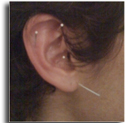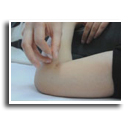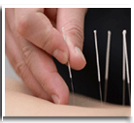|
|

 |
 |
Treat
for Fibromyalgia Syndrome (FMS) with Acupuncture
Fibromyalgia Syndrome (FMS)
affects an estimated 2 percent of the population. Conventional
therapies are limited in the success of treating this complex and
unexplained condition. Current treatment is largely comprised of
prescribing different medications for the varying symptoms in a trial
and error approach. Research shows that as many as 90 percent of
people with fibromyalgia have turned to complementary and alternative
medicine to manage their symptoms. Acupuncture, in particular, has
become a popular treatment choice and has shown to be an effective
treatment for FMS.
What is Fibromyalgia Syndrome?
Fibromyalgia is a medically unexplained syndrome characterized by
chronic widespread pain, a heightened and painful response to
pressure, insomnia, fatigue, and depression. While not all affected
persons experience all associated symptoms, the following symptoms
commonly occur together:
-
chronic pain
-
debilitating fatigue
-
difficulty sleeping
-
anxiety and depression
-
joint stiffness
-
chronic headaches and jaw pain
-
difficulty swallowing
-
dryness in mouth, nose, and eyes
-
hypersensitivity to odors, bright lights, and
loud noises
-
inability to concentrate (called "fibro fog")
-
incontinence
-
irritable bowel syndrome
-
numbness or tingling in the fingers and feet
-
painful menstrual cramps
-
poor circulation in hands and feet (called
Raynaud's phenomenon)
-
restless legs syndrome
Fibromyalgia is diagnosed when
there is a history of widespread pain in all four quadrants of the body
for a minimum duration of three months and pain when pressure is applied
to at least 11 of 18 designated tender points on the body. This
condition does not result in any physical damage to the body or its
tissues and there are no laboratory tests which can confirm this
diagnosis.
Symptoms often begin after a physical or emotional trauma, but in many
cases there appears to be no triggering event. Women are more prone to
develop the disorder than are men, and the risk of fibromyalgia
increases with age.
From an Eastern Perspective
The Oriental medicine theory of pain is expressed in this famous Chinese
saying: "Bu tong ze tong, tong ze bu tong" which means
"free flow: no pain, no free flow: pain." Pain is seen as a
disruption of the flow of Qi within the body. The disruption of Qi that
results in fibromyalgia is usually associated with disharmonies of the
Liver, Spleen, Kidney and Heart Systems.
The Acupuncture Treatment
Oriental Medicine does not recognize fibromyalgia as one particular
disease pattern. Instead, it aims to treat the specific symptoms that
are unique to each individual depending on their constitution, emotional
state, intensity and location of their pain, digestive health, sleeping
patterns and an array of other signs and symptoms. Therefore, if 10
people are treated with Oriental medicine for fibromyalgia, each of
these 10 people will receive a unique, customized treatment with
different acupuncture points, different herbs and different lifestyle
and dietary recommendations.
Because the symptoms of fibromyalgia are highly variable form one person
to another, a wide array of traditional and alternative treatments has
been shown to be the most effective way of treating this difficult
syndrome. A treatment program may include a combination of psychological
or behavioral therapies, medications, exercise, acupuncture, herbal
medicine and bodywork.
If you have fibromyalgia, acupuncture and Oriental medicine may
be what you’ve been looking for to ease your symptoms and reclaim your
health and vitality. Please call for a consultation today.
Attached Scientific Evidence that Acupuncture Works for
Fibromyalgia and Chronic Pain
New Evidence that Acupuncture Works for Fibromyalgia and Chronic
Pain
By: University of Michigan
Researchers at the University of Michigan Chronic Pain and
Fatigue Research Center are first to provide evidence of acupuncture's
effect on opoid receptors.
Acupuncture has been used in East-Asian medicine for thousands of years
to treat pain, possibly by activating the body’s natural painkillers.
But how it works at the cellular level is largely unknown.
Using brain imaging, a University of Michigan study is the first to
provide evidence that traditional Chinese acupuncture affects the
brain’s long-term ability to regulate pain. The results appear online
ahead of publication in the September issue of Journal of NeuroImage.
In the study, researchers at the U-M Chronic Pain and Fatigue Research
Center showed acupuncture increased the binding availability of mu-opoid
receptors (MOR) in regions of the brain that process and dampen pain
signals – specifically the cingulate, insula, caudate, thalamus and
amygdala.
Opioid painkillers, such as morphine, codeine and other medications, are
thought to work by binding to these opioid receptors in the brain and
spinal cord.
"The increased binding availability of these receptors was associated
with reductions in pain," says Richard E. Harris, Ph.D., researcher at
the U-M Chronic Pain and Fatigue Research Center and a research
assistant professor of anesthesiology at the U-M Medical School.
One implication of this research is that patients with chronic pain
treated with acupuncture might be more responsive to opioid medications
since the receptors seem to have more binding availability, Harris says.
These findings could spur a new direction in the field of acupuncture
research following recent controversy over large studies showing that
sham acupuncture is as effective as real acupuncture in reducing chronic
pain.
"Interestingly both acupuncture and sham acupuncture groups had similar
reductions in clinical pain," Harris says. "But the mechanisms leading
to pain relief are distinctly different."
The study participants included 20 women who had been diagnosed with
fibromyalgia, a chronic pain condition, for at least a year, and
experienced pain at least 50 percent of the time. During the study they
agreed not to take any new medications for their fibromyalgia pain.
Patients had position emission tomography, or PET, scans of the brain
during the first treatment and then repeated a month later after the
eighth treatment.
Reference: Journal of NeuroImage, Volume 47, Issue 3, September 2009,
Pages 1077-1085 doi:10.1016/j.neuroimage.2009.05.083
|
Other Conditions
Commonly Treated by Dr. Zheng
- Hot flashes,
menopause, PMS, irregular menstruation
- Stress, depression, anxiety,
insomnia, fatigue
- Hey-fever, sinusitis, asthma,
bronchitis
- Infertility, impotence
- Dizziness, vertigo, Meniere’s disease
- Hypertension, diabetes, obesity
- Stroke, paralysis, Bell’s palsy
- Indigestion, diarrhea, constipation
- Quitting smoking, beauty &
rejuvenation
SPECIAL SERVICES
- We offer free initial consultation
- We accept health insurance plans
which cover for acupuncture treatment. We may contact
your insurance company to verify your acupuncture
benefits. If you need us to do so, please tell us your
insurance information including your full name,
birthday,insurance ID number, and insurance company’s
Tel. number.
|
|
|




